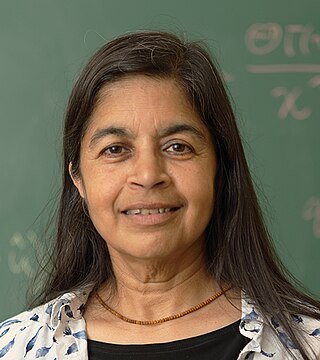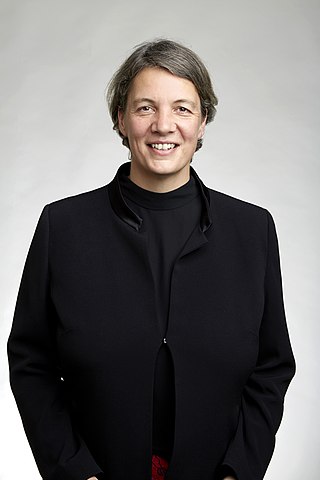
Bryan Malcolm Gaensler is an Australian astronomer based at the University of California, Santa Cruz. He studies magnetars, supernova remnants, and magnetic fields. In 2014, he was appointed as Director of the Dunlap Institute for Astronomy & Astrophysics at the University of Toronto, after James R. Graham's departure. He was the co-chair of the Canadian 2020 Long Range Plan Committee with Pauline Barmby. In 2023, he was appointed as Dean of Physical and Biological Sciences at UC Santa Cruz.

David John Hugh Cockayne FRS FInstP was Professor in the physical examination of materials in the Department of Materials at the University of Oxford and professorial fellow at Linacre College from 2000 to 2009. He was the president of the International Federation of Societies for Microscopy from 2003 till 2007, then vice-president 2007 to 2010.
The Pawsey Medal is awarded annually by the Australian Academy of Science to recognize outstanding research in the physics by an Australian scientist early in their career.
Gordon Wallace, AO, FAA, FTSE, FRACI is a leading scientist in the field of electromaterials. His students and collaborators have pioneered the use of nanotechnology in conjunction with organic conductors to create new materials for energy conversion and storage as well as medical bionics. He has developed new approaches to fabrication that allow material properties discovered in the nano world to be translated into micro structures and macro scopic devices.
Amanda Susan Barnard is an Australian theoretical physicist working in predicting the real world behavior of nanoparticles using analytical models and supercomputer simulations and applied machine learning. Barnard is a pioneer in the thermodynamic cartography of nanomaterials, creating nanoscale phase diagrams relevant to different environmental conditions, and relating these to structure/property maps. Her current research involves developing and applying statistical methods and machine/deep learning in nanoscience and nanotechnology, and materials and molecular informatics. In 2014 she became the first person in the southern hemisphere, and the first woman, to win the Feynman Prize in Nanotechnology, which she won for her work on diamond nanoparticles.

Nalini Joshi is an Australian mathematician. She is a professor in the School of Mathematics and Statistics at the University of Sydney, the first woman in the School to hold this position, and is a past-president of the Australian Mathematical Society. Joshi is a member of the School's Applied Mathematics Research Group. Her research concerns integrable systems. She was awarded the Georgina Sweet Australian Laureate Fellowship in 2012. Joshi is also the Vice-President of the International Mathematical Union, and is the first Australian to hold this position.

Benjamin John Eggleton,, is Pro Vice Chancellor (Research) at the University of Sydney. He is also Professor in the School of Physics where he leads a research group in integrated photonics, nonlinear optics and smart sensors and serves as co-director of the NSW Smart Sensing Network (NSSN).

Michelle Yvonne Simmons is an Australian quantum physicist, recognised for her foundational contributions to the field of atomic electronics.

Tanya Mary Monro is an Australian physicist known for her work in photonics. She has been Australia's Chief Defence Scientist since 8 March 2019. Prior to that she was the Deputy Vice Chancellor, Research and Innovation (DVCR&I) at the University of South Australia. She was awarded the ARC Georgina Sweet Australian Laureate Fellowship in 2013. She was the inaugural chair of photonics, the inaugural director of the ARC Centre of Excellence for Nanoscale Biophotonics and the inaugural director of the Institute for Photonics & Advanced Sensing (IPAS), and the inaugural director of the Centre of Expertise in Photonics (CoEP) within the School of Chemistry and Physics at the University of Adelaide. Monro has remained an adjunct professor of physics at the University of Adelaide following her departure from the institution. In 2020 she was awarded the title of Emeritus Professor at the University of South Australia.
Martina Heide Stenzel is a Professor in the Department of Chemistry at the University of New South Wales (UNSW). She is also a Royal Australian Chemical Institute (RACI) University Ambassador. She became editor for the Australian Journal of Chemistry in 2008 and has served as Scientific Editor and as of 2021, as Editorial Board Chair of RSC Materials Horizons.
Catherine "Cathy" J. Murphy is an American chemist and materials scientist, and is the Larry Faulkner Professor of Chemistry at the University of Illinois at Urbana-Champaign (UIUC). The first woman to serve as the head of the department of chemistry at UIUC, Murphy is known for her work on nanomaterials, specifically the seed-mediated synthesis of gold nanorods of controlled aspect ratio. She is a member of the American Association for the Advancement of Science, National Academy of Sciences, and the American Academy of Arts and Sciences in 2019.
Chennupati Jagadish, an Indian-Australian physicist and academic, is the President of the Australian Academy of Science, and a Distinguished Professor of Physics at the Australian National University Research School of Physics. He is head of the Semiconductor Optoelectronics and Nanotechnology Group which he established in 1990. He is also the Convener of the Australian Nanotechnology Network and Director of Australian National Fabrication Facility ACT Node.
Marcela Bilek is a Professor of Applied Physics and Surface Engineering at the University of Sydney, Australia. Her research interests focus on the use of plasma related methods to synthesise thin film materials and modify surfaces and interfaces. She was named Fellow of the American Physical Society in 2012 and Fellow of the Institute of Electrical and Electronics Engineers (IEEE) in 2015 for contributions to the science and application of plasma processes for materials modification and synthesis.
The Australian Laureate Fellowship is an Australian professorial research fellowship awarded by the Australian Research Council. Fellows are chosen each year for five-year awards. In 2023 8 industry-focused Laureate Fellowships were awarded for the first time.
Halina Rubinsztein-Dunlop is a professor of physics at the University of Queensland and an Officer of the Order of Australia. She has led pioneering research in atom optics, laser micro-manipulation using optical tweezers, laser enhanced ionisation spectroscopy, biophysics and quantum physics.
Professor Lan Wang is a Chinese-Australian material scientist known for expertise in materials synthesis and advanced materials characterisation.
Susan Nan Coppersmith is an American condensed matter physicist. Formerly the Robert E. Fassnacht Professor of Physics and Vilas Research Professor in the Department of Physics at the University of Wisconsin–Madison, she moved in 2018 to the University of New South Wales.
Kaarin Anstey is an Australian Laureate Fellow and one of Australia's top dementia scientists. She is Co-Deputy Director of the ARC Centre of Excellence in Population Ageing Research (CEPAR) at the University of New South Wales, Australia, where she is Scientia Professor of Psychology. Kaarin Anstey is an Honorary Professor at the Australian National University and a Fellow of the Academy of the Social Sciences in Australia. She is a Director of the NHMRC Dementia Centre for Research Collaboration, Senior Principal Research Scientist at NeuRA and leads the NHMRC Centre of Research Excellence in Cognitive Health and the UNSW Ageing Futures Institute.
Andrew L. GoodwinFRS is a university research professor and professor of materials chemistry at the University of Oxford.

Susan Buthaina Sinnott is professor and head of materials science and engineering at Pennsylvania State University. Sinnott is a fellow of the Materials Research Society (MRS), the American Association for the Advancement of Science (AAAS) and the American Physical Society (APS). She has served as editor-in-chief of the journal Computational Materials Science since 2014.






